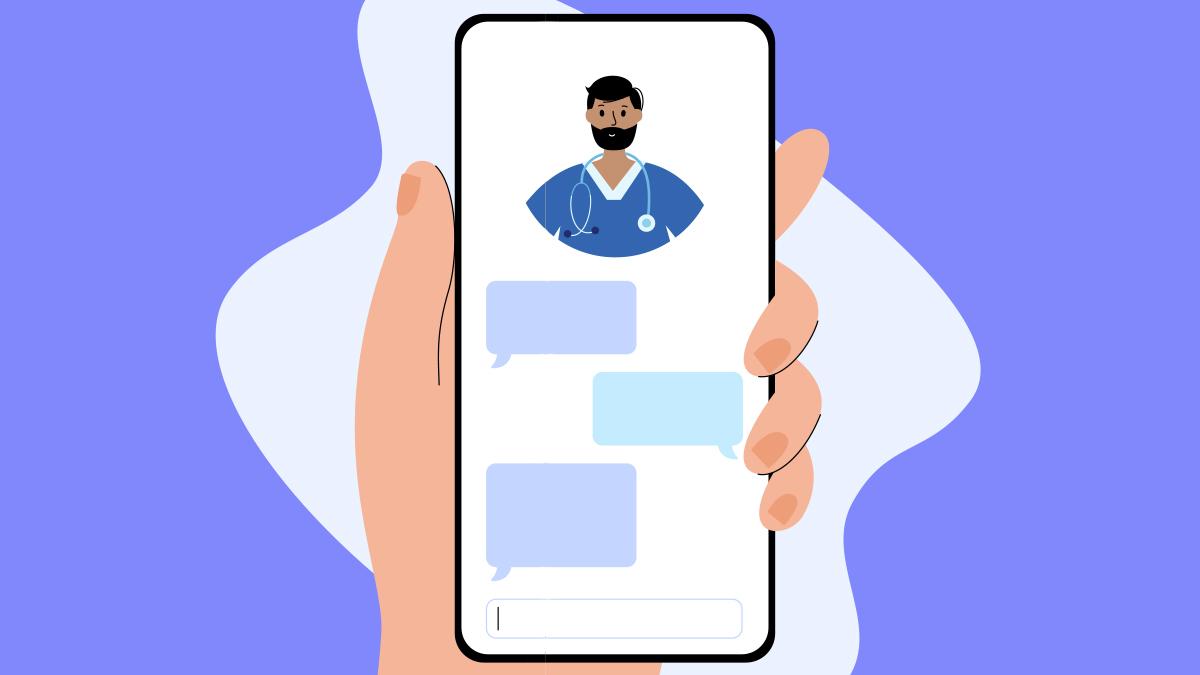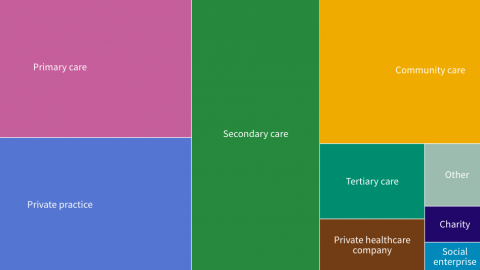We present some of the headline results of the CSP’s recent evaluation of remote physiotherapy services during the pandemic

Remote physiotherapy consultations might not be new but they became a way of life during the Covid-19 pandemic. Almost overnight, services had to adapt to ensure they could still provide care and management to patients at a time when face-to-face appointments were severely curtailed, or even stopped altogether.
Now, Frontline can report the first findings of a comprehensive evaluation of remote consultations in the pandemic, based on an online survey of more than 1,600 services across all settings and clinical and geographical areas in the UK.
The results give a mixed picture – many services report that moving online has been beneficial to patients and staff, while others talk of technical glitches and a fear that physiotherapy would lose its unique hands-on identity if face-to-face appointments were radically cut.
‘There were some good experiences and some not so good experiences,’ says one of the research team, Sarah Tyson, professor of rehabilitation at the University of Manchester, who is a physiotherapist. ‘It works really well for some people and not for others, which I guess is what I would have expected. This research gives us a commentary, a documentary on what’s happened and how people reacted. It gives us the upside and the downside of it. There will be a lot of lessons of good practice and how people have overcome barriers. We’ll be highlighting concerns and the negatives as well and I hope it will be useful for the future.’
Back in June, the CSP commissioned the research team at the University of Manchester to undertake an evaluation of remote physiotherapy consultations during the pandemic, aiming to gain an increased understanding of the delivery of remote physiotherapy.
Wealth of data
As well as the survey, the project includes a scoping review of studies into remote delivery and physiotherapy; it will also involve the development of in-depth case studies and workshops to confirm findings. The overall goal is to show which types of remote physiotherapy services are successful in different contexts, give recommendations for successful implementation, to identify pitfalls and challenges, and to give examples of good service models.
Helen Hawley-Hague, a National Institute of Health Research (NIHR) Research Fellow in the School of Health Sciences at the University of Manchester, and a member of the CSP’s Digital and Informatics Physiotherapy Group, is leading the project. She was impressed both at the number of services that responded to the survey of service leads, and the level of qualitative information that came out of the ‘free text’ questions.
‘This survey was designed as a mapping exercise and it has generated a wealth of data,’ says Dr Hawley-Hague. ‘We’ve got representation across all of the different disciplines, different locations, and different countries of the UK, so we were very pleased with the response. We’re in the process of choosing case studies for the next stage of the research, and the qualitative data [based on open questions] is really interesting. The idea was to give people a chance to tell us what they thought about what was going on, and they have certainly done that.’
More than 1,600 service leads responded to the survey, covering a diverse range of settings including primary, secondary and tertiary care; NHS and private, charities, hospices and mental health services. While the greatest number of responses concerned musculoskeletal (MSK), a wide range of clinical areas were represented in the responses. Service leads from all four countries, from urban and rural settings, took the opportunity to share their experiences.
Range of platforms
The survey reveals that physiotherapists used remote consultations for a range of purposes, from initial triage and screening to progressing treatment and follow-on appointments. They also employed a variety of technological platforms, from the humble telephone (the most popular, used by some 950 of the respondents) to well-known applications such as Zoom and Microsoft Teams, as well as some specific healthcare platforms.
Respondents were asked about how they developed the remote service and whether they evaluated it. Just under a third (31.7 per cent) were able to define patient population and referral criteria for their remote service. This ranged from a digital-first approach for all but those who needed emergency intervention, to specialist services that primarily booked complex patients for an initial face-to-face consultation unless they were a particular Covid risk.
Positives and barriers
Commonly identified barriers included set-up of equipment and connectivity, and its suitability for patients, particularly those who were older and/or had cognitive difficulties or were not familiar with or able to cope with the technology. Several service leads also warned it could be stressful and exhausting for staff who were worried they might ‘miss something’ in diagnosis and assessment if they didn’t do it in person.
The main positives highlighted were the flexibility of delivery and people not having to come to clinics and a necessity to enable continued delivery throughout lockdown. Remote consultations were seen as particularly useful for some triage, assessments and follow-ups.
As well as the case studies and workshops, the research team (which includes Dr Reena Lasrado and Dr Emma Stanmore) plan to disseminate the results of the evaluation so far and encourage discussion. Dr Hawley-Hague and Prof Tyson have already presented some of their findings at Virtual Physiotherapy UK 2020 and received fantastic feedback.
‘We want to say thank you to everyone who has taken part in the survey,’ says Fran Hallam, research into practice adviser with the CSP. ‘The response really highlights that this is an important topic for the profession. We’re very grateful to those who took the time to share their experiences and are looking forward to the next steps.’
Key findings from the UK-wide survey of 1620 services
- A variety of platforms were in use: the most popular was the telephone (around 950), followed by Attend Anywhere (just over 500), Zoom (around 380) and Microsoft Teams (just over 300). Others included Skype, FaceTime, AccuRx and WhatsApp.
- Just over half (51.7%) said they had experienced challenges setting up remote services, 37.5% said they had only been able to overcome these challenges in some circumstances.
- More than a quarter (27.8%) involved patients/carers/ family in developing the remote service. 10% involved patients/carers/family in developing any evaluation measures. Almost 4 in 10 had a service specification or standardised operating procedures to guide delivery of remote consultations.
Services used remote delivery for a variety of reasons including*:
- 83 per cent used it as part of the initial assessment
- 76 per cent for follow-up and to progress treatment
- 74 per cent to prescribe exercise
- 74 per cent to monitor and review progress
- 70 per cent to provide self-management support and 67 per cent for screening and triage.
- It was also used to deliver group exercise (17 per cent) or to deliver education in a group (12 per cent)
Service evaluation*
- evaluate patient experience 49.3%
- evaluate patient outcomes 53%
- evaluate digital exclusion 19%
- evaluate staff experience 20.1%
- evaluate time to deliver the service 21.3%
- evaluate cost 12.5%
- evaluate patient-related incidences 10.6%
* Please note the percentages cited here were calculated from the 1,620 overall respondents to the survey but there was variable missing data across questions.
What physios said in response to the survey
- ‘Lots of patients comment on how convenient the online appointments are, especially for rehab review.’
- ‘Anecdotally across my caseload patients are overwhelmingly negative about telehealth, but feel it’s better than nothing and would prefer “proper” physio.’
- ‘There is also increased risk to the patient because we cannot complete a full objective assessment.’
- ‘A surprising amount of objective assessment on quality of movement, balance impairment can be assessed on video.’
- ‘Virtual appointments have revolutionised my practice! I love being able to see patients doing their exercise in their home environment.’
- ‘I am finding remote consultations exhausting and isolating as a clinician.’
- ‘I worry about the educational future of the profession and that funding cuts are using this opportunity as a way of cutting costs.’
- ‘Technical glitches are frustrating for patients and clinicians.’
- ‘Delivery takes as much if not more time than face to face.’
- ‘Remote consultation can be a very useful triage tool, saving time and travel within the community, and helps to prioritise urgent cases more rapidly.’
- ‘Our waiting list has gone down more rapidly compared to normal. We’re doing part of our initial assessment over the phone, which saves time completing this in the patient’s home.’
Number of subscribers: 1





































